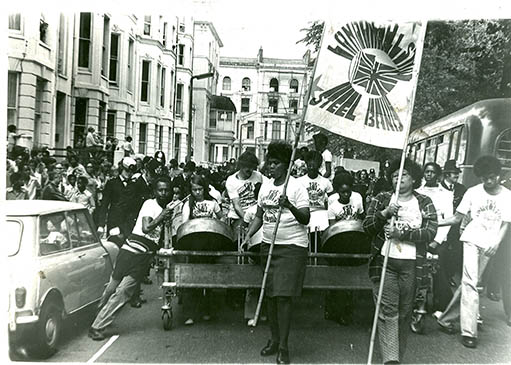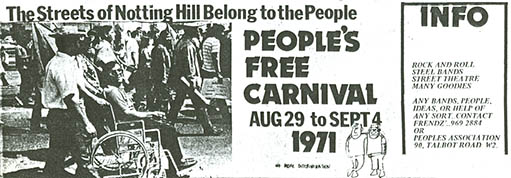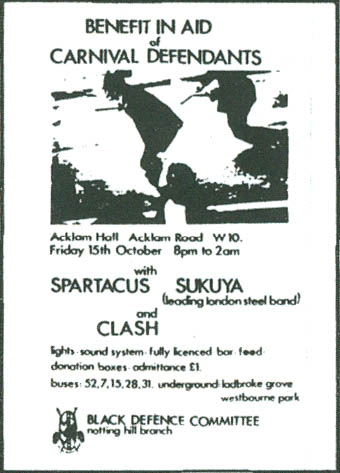|
PORTOBELLO CARNIVAL FILM FESTIVAL 2008
1 Portobello Carnival Film Festival 2008
2 Lord Holland’s Slavery to Work Scheme
3 The Notting Dale Gypsies
4 Portobello Busker Parades
5 1966 London Free School Michaelmas Fayre
6 1968 Interzone International Times Fair
7 1977 Two Sevens Clash Punky Reggae Party
8 1983/4 Aswad Live And Direct Carnival
9 1995 Hugh Grant Mas and Mayhem
PART 6
1968 Interzone International Times Fair
‘Walking the Grove’ in the May ’68 ‘Interzone’ International Times, Courtney Tulloch concluded that ‘Notting Hill in its social aspects – housing and so on – is a huge grimy garbage heap, that is just waiting to get set on fire… In the meantime, look forward to the Notting Hill Fair especially, a human bonfire of energy and colour. Don’t wait for the area to change – no change in a physical environment how ever great can ever change you. Instead dig the vibrations in and around Notting Hill, perhaps the only area in London where through the differing enclaves of experimental living, a free-form and ingenious communal life-style could really burst forth… Now there are signs that a real underground community is alive, and especially in the village around Portobello Road, down to the Gate. Each person will carry a fire in their heads despite (perhaps because of) the garbage, the ghetto poverty and the rest.’
1969 King Mob Situationist Carnival
The year of ‘Getting It Straight In Notting Hill Gate’ by Quintessence, the Situationist King Mob group presented a ‘Miss Notting Hill ’69’ Carnival float, featuring a girl with a giant syringe attached to her arm. This was ‘a comment on the fact that there was junk and junk, the hard stuff, or the heroin of mindless routine and consumption.’
1970 Notting Hill People’s Free Carnival
The weekend before the 1970 Notting Hill Fair/Carnival, Mick Farren and the Pink Fairies represented the Grove at a demo in Trafalgar Square, in solidarity with ‘East End squatters, Notting Hill blacks, and Piccadilly freaks.’ The next day Hawkwind headlined a space-rock skinhead moonstomp on Wormwood Scrubs. Ironically, as the voice of the black community began to be heard at the start of the 70s, if anything Notting Hill Carnival became more of a hippy festival. After Rhaune Laslett’s original Carnival committee pulled out due to the racial tension in the area in the wake of the first Mangrove bust, the radical street hippies took over. The 1970 Notting Hill ‘People’s Carnival’ consisted of a procession round the area, starting and finishing in Powis Square, led by Ginger Johnson’s African drummers and a witchdoctor. Proceedings ended with a rock festival in the square gardens featuring the American band Socca/Sacatash, Mataya, Stackhouse, James Metzner ‘and various local musicians.’

1971 Angry Hippy Carnival
In the run-up to the Angry Notting Hill Carnival of 1971, Frendz made ‘a call to all progressive people; black people smash the racist immigration bill; workers of Britain smash the Industrial Relations bill. All progressive people unite and smash growing fascism. Rally and march July 25, Acklam Road, Ladbroke Grove 2pm. Black Unity and Freedom Party.’ On the gatefold sleeve of Hawkwind’s 1971 album ‘X In Search of Space’, designed by Barney Bubbles, the group are pictured playing a free gig under the Westway. That summer Hawkwind appeared on several occasions at different locations under the flyover, including the Westway Theatre on the site of the Portobello Green Arcade and to the east (where Neighbourhood nightclub would later appear). These gigs were usually benefits for local causes, during which they would merge with the Pink Fairies as Pinkwind.
The underground press ad for the ‘People’s Free Carnival August 29 – September 4 1971’ proclaimed: ‘The Streets of Notting Hill belong to the people – rock’n’roll – steel bands – street theatre – many goodies – any bands, people, ideas, or help of any sort, contact Frendz or People’s Association, 90 Talbot Road W2.’ The FreeFrendz ‘Blow Up’ Angry Brigade special reported that the ‘People’s Carnival got off to a joyous start. The street fest continues all this week so do it in the road as noisily as you can.’ The Pink Fairies were pictured amongst the kids in the Powis Square gardens, ‘at a quieter moment during the Notting Hill Free Carnival, a fantastic week of music, theatre and dancing in the street. Everybody got it on and the streets really came alive.’ Pictures of Mighty Baby and Skin Alley playing on the site of Portobello Green were captioned: ‘The weekly Saturday concert under Westway in Portobello Road pounds on. Next week Graham Bond, Pink Fairies and Hawkwind.’
The local street hippies Skin Alley told Frendz of an anti-common market demo in Powis Square, with Julie Driscoll and some ‘very far out modern jazz trios’ who didn’t go down too well with the kids. Powis Square, during the 1971 Carnival, was also the unlikely venue of the debut with Hawkwind of the former Hendrix roadie, Ian ‘Lemmy’ Kilmister (or Kilminster), later of Motörhead. The Carnival procession consisted of a steel band led by Merle Major, an angry West Indian mother of 6, chanting “Get involved, Power to the People”; from her old house on St Ervan’s Road to Powis Square, where the People’s Association had opened a squat for her. As an effigy of her landlord was burnt, Merle Major sang the ’71 Carnival hit, ‘Fire in the Hole’, which included the line, ‘the people of the borough pay for your car.’ The Angry Carnival HQ on Talbot Road was subsequently busted by the bomb squad.

1972/3 Calypso Carnival
From the early to mid 70s, under the administration of the Trinidadian Leslie Palmer, the Notting Hill hippy ‘fayre’ was transformed into ‘an urban festival of black music’, based on the Trinidad Carnival model. From the first Carnival HQ on Acklam Road, Leslie Palmer established the blueprint of the modern event; getting sponsorship, recruiting steel bands and sound-systems, introducing generators and extending the route. The attendance went up accordingly from 3,000 at the beginning of the 70s to 50,000 in 1973.
1974/5 Reggae Carnival
By the mid 70s, Jamaican reggae was challenging Trinidadian calypso’s dominance of Notting Hill Carnival. At the 1974 flares and platforms Carnival, the Trinidadian organiser Leslie Palmer introduced reggae sound-systems and the Cimarons played, thus attracting black youth from all over London, rather than just locals. In 1975 the turnout reached 100,000, and the Carnival’s press profile changed from harmless hippy fair to public order problem. Back in Trinidad, as Michael X was executed, the calypsonian Black Stalin sang: ‘Go rap to them baldhead, tell them, calypso gone dread.’
1976 Carnival Police Clash

In 1976, as Darcus Howe’s militant Carnival committee and the Golborne 100 group (led by George Clark, the 1967 Summer Project saint-turned-anti-Carnival sinner) joined the fray, as well as the Clash there were 1,500 white men in uniform in Notting Hill. In the Armagideon Times fanzine ‘Story of the Clash’, Joe Strummer recalled getting caught up in the first incident under the Westway. After a group of ‘blue helmets sticking up like a conga line’ went through the crowd, one was hit by a can, immediately followed by a hail of cans:
‘The crowd drew back suddenly and the Notting Hill riot of 1976 was sparked. We were thrown back, women and children too, against a fence which sagged back dangerously over a drop. I can clearly see Bernie Rhodes, even now, frozen at the centre of a massive painting by Rabelais or Michelangelo… as around him a full riot breaks out and 200 screaming people running in every direction. The screaming started it all. Those fat black ladies started screaming the minute it broke out, soon there was fighting 10 blocks in every direction.’ Joe later recalled failing to set a car alight with a box of matches along Thorpe Close.
Meanwhile on Portobello Road, Don Letts (the future Clash associate film director) was walking into pop history towards Acklam Road – passing the Black People’s Information Centre sound-system/disco unit, hippies looking out of the upstairs windows of numbers 305 to 9, and a line of policemen – as Rocco Macaulay began taking his famous series of pictures of the next charge. Macaulay’s shot of police reaching the Westway, where the black youths had gathered (now the Portobello Green arcade) duly became the back cover of ‘The Clash’ album and the ‘White Riot’ tour backdrop projection. Don Letts’ Wild West 10 walk first appeared on the sleeve of the ‘Black Market Clash’ mini-LP in 1980.
As the riot raged under the Westway, alongside hoardings sprayed with ‘Same thing day after day – Tube – Work… How much more can you take’, with the youths being driven up Tavistock Road towards All Saints Road, in what could be an apocryphal report a drunk staggered between the police and youth lines, causing hostilities to temporarily cease until he stumbled off over a wall. Later that night, Joe Strummer, Paul Simonon and Sid Vicious were warned off by a black woman when they attempted to enter the West Indian Metro youth club on Tavistock Road.
The Sun’s ‘Carnival of Terror’ feature included the Sun ‘man on the spot’ reporting on ‘How I was kicked at Black Disco’ – Acklam Hall under the Westway (on the site of 12 Acklam Road/Neighbourhood nightclub). The reggae promoter Wilf Walker remembers Acklam Road in ’76 as a spiritual awakening of black Britain: “It was incredible in those days to be in a sea of black faces. As a black person, that kind of solidarity we don’t experience anymore… We described it as a demo of solidarity and peace within the black community. I can’t imagine what it would have been like for white people… ’76 showed the strength of feeling, reggae was raging in those days, young blacks weren’t into being happy natives, putting on a silly costume and dancing in the street, in the same street where we were getting done for sus every day.”
Wilf Walker’s Acklam Hall punky reggae party began with a Black Defence Committee benefit ‘in aid of Carnival defendants’; featuring Spartacus R (from Osibisa), the Sukuya steel band, and ‘Clash’ were billed (with no ‘The’) but didn’t actually play. As Joe Strummer told the NME, “It wasn’t our riot, though we felt like one.” Although the Clash already existed, it can be argued that they were a pop culture echo of the 1976 riot, like Absolute Beginners was of 1958. Marcus Gray calls it ‘the catalyst that brought to the surface a lot of disparate elements already present’ in the group. Not least, they got into reggae, feeding dub effects, ‘heavy manners’ stencil graffiti and the apocalyptic Rasta rhetoric into the mix.
The NME reggae buff Penny Reel cites the Dennis Brown tracks ‘Wolf and Leopard’, ‘Whip them Jah’ and ‘Have No Fear’ as portents of ‘War inna Babylon’, played by Lloyd Coxsone under the Westway and Observer Hi-fi on Kensington Park Road (outside the newly opened original Rough Trade shop) in ’76. In the reggae riot response, the Pioneers lamented the ‘Riot in Notting Hill’ on Trojan, the Trenchtown label came up with ‘Police Try Fe Mash Up Jah Jah Children’ by Mike Durane, and the Morpheus label had their own militant take on ‘Police and Thieves’, ‘Police and Youth in the Grove’/‘Babylon A Button Ladbroke Dub’ by Have Sound Will Travel (promoted with a punky riot headline flyer). Aswad had already recorded ‘Three Babylon’ (‘Three Babylon tried to make I and I run, they come to have fun with their long truncheons’) about a police incident under the Westway before the ’76 riot.

7 1977 Two Sevens Clash Punky Reggae Party
|








